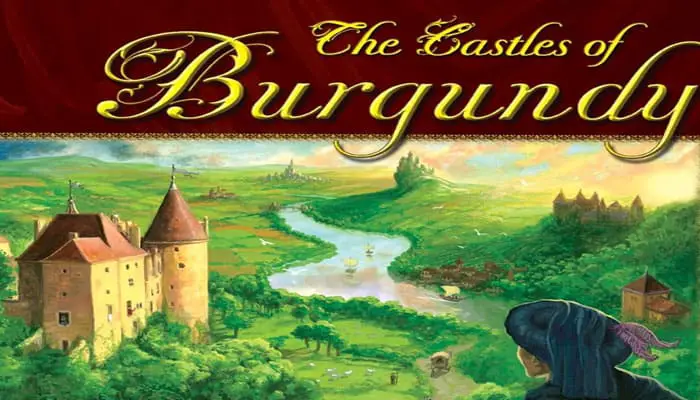
Game Components

- 164 six-sided tiles:
- 42 goods tiles (square, 7 in each of 6 colours)
- 20 Silverlings (eight-sided)
- 30 worker tiles (square)
- 12 bonus tiles (square, 1 small and 1 large in each of 6 colours)
- 4 victory point tiles (with 100 / 200 points in each of the 4 player colours)
- 8 playing pieces (2 in each of the 4 player colours)
- 9 dice (2 in each of the 4 player colours plus 1 white one)
- 1 game board
- 6 player boards (double-sided, 4x No. 1, 1 each of Nos. 2-9)
Setup
Place the 20 Silverlings, the 30 worker tiles as well as the white die next to the game board. Sort the 164 six-sided tiles according to the colour of their backs and place them, as separate face-down supplies, next to the game board.
Shuffle the 42 goods tiles (square tiles) face down. Then separate them into 5 face-down piles, each made up of 5 tiles. Place one pile onto each of the 5 phase spaces lettered A through E on the game board. The remaining 17 tiles remain in a face-down supply for now.
Place the 12 bonus tiles (square) onto the corresponding spaces on the game board.
Give each player:
- 1 player board, placed with the Number 1 side face up in front of himself (for boards with the numbers 2 through 9)
- 1 castle (= dark green six-sided tile), to be placed face up onto the dark green middle space (with the die value 6) of his player board
- 3 random goods tiles from the remaining 17 tiles, to be placed face up onto the three goods storage spaces in the upper left hand corner of his board: tiles of the same goods type (= colour) are stored together, different types are stored separately (any remaining goods tiles are not used in the game and are returned to the box).
- the 2 dice in his colour
- 1 playing piece in the same colour, to be placed onto the 0/100 space of the victory point track
- 1 Silverling, to be placed in the appropriate storage space in the upper left hand corner of his board, visible to all other players
- 1 victory point tile (with 100 / 200), to be placed next to his board for now
Determine a start player by rolling dice. That player receives one worker tile which he places onto the appropriate storage space in the lower left hand corner of his board, visible to all other players. The next player in clockwise direction receives 2 worker chips, the third player receives 3 and the fourth player receives 4.
Each player uses their second playing piece to mark the just-determined playing order on the first space of the turn order track: The start player's piece should be on top in the tower and the last player's piece should be at the bottom. Give the start player the white die.
The Player Boards:
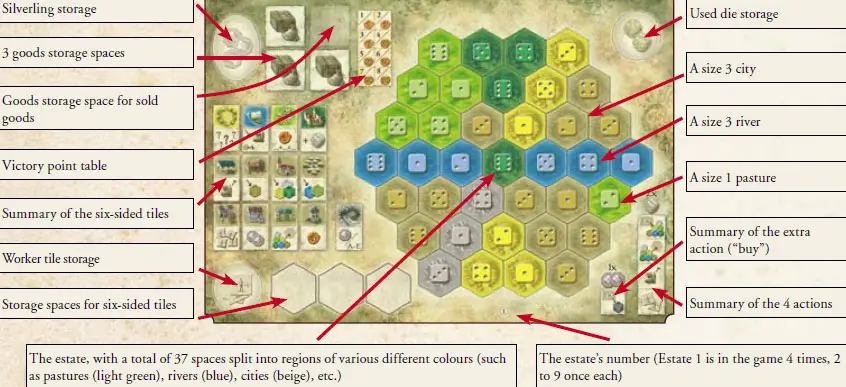
Game Play
At the start of each phase, the following setup is carried out:
Remove all six-sided tiles remaining on the board and return them to the box (naturally not required before the first phase).
(Note: Ship, mine and castle tiles can be left in place as they are all the same! Any remaining goods tiles are also left on the board).
Randomly draw new six-sided tiles and place them, face-up, onto the matching-coloured six-sided spaces in the six numbered depots: In a 2-player game only those spaces marked with 2s (12 spaces), in a 3-player game only those spaces marked with 2s and 3s (18 spaces), and in a 4-player game all 24 spaces will have tiles placed onto them.
Note: In the three-player game only, there is an exception for the dark green space in the No. 6 depot: In phases A, C and E a castle is placed onto it as normal, but in phases B and D a mine (grey) is placed there instead!
Randomly draw black-backed six-sided tiles and place them, face-up, onto the black depot in the middle of the game board (draw 2 to 8 tiles, depending on player number).
Take the 5 goods tiles for the current phase and place them, face-up, onto the five square round spaces below the phase spaces.
The five game rounds
After phase setup, five game rounds follow, each of which is carried out in the same manner:
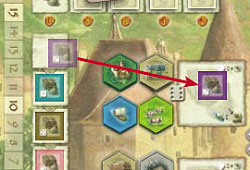
First, all players roll their two dice, with the start player also rolling the white die. Then all players place their dice in front of themselves so that all players can see them.
Note: Rolling simultaneously allows those players whose turns come later to start planning their turns ahead of time.
The start player starts. First, he takes the topmost goods tile from the round spaces and places it onto the goods space of the depot whose number matches the number rolled on the white die.
With this, the white die's function for this turn is complete; it cannot be used by the start player to assist him on his own turn (and can never be adjusted via worker tiles!).
Thereafter, the start player carries his turn out. It is then the turn of the next player in turn order (moving from right to left on the turn order track and from top to bottom in a given tower). Once each player has had a turn, a new round begins, etc. As 5 goods tiles are added each phase and since one tile is added to a depot at the start of each round, it is easy to tell which round the current one is and how long the current phase (and by extension the entire game) will last.
A player's turn
...consists of carrying out exactly two actions, one per die. Once a die has been used, it is placed onto the used die storage space in the upper right hand corner of the player's board.
Worker tiles: These may be used at any time (a tile, once used, is returned to the general supply) to adjust a die's result up or down by 1. Changing a die's result from 1 to 6 or from 6 to 1 is also permitted and also costs one worker tile. Players may use multiple tiles to change a die's result multiple times.
Example: By paying 2 worker tiles, Anna can turn a 2 into a 6 and subsequently take a six-sided tile from the No. 6 depot.
The Actions
A die is required for each action. The two actions per turn may be carried out in any combination and order (including carrying the same action out twice).
Action Take six-sided tile from the game board

The player may take one six-sided tile of their choice from the depot whose number corresponds to the result of the die used to carry out the action. The chosen tile is placed onto an empty storage space in the bottom left-hand corner of his board (never directly into his estate!). Should all of the storage spaces be full, then he must first choose a prior tile to discard (thus removing it from the game) and subsequently place the new tile onto the newlyemptied space (players should try to minimize how often they have to discard tiles).
Action Add six-sided tile to your estate

The player may take one six-sided tile of his choice from the storage area in the lower left-hand corner of his board and add it to his estate. The die chosen to carry out this action indicates which corresponding empty space he may place the tile onto. All newly-placed tiles must always lie directly adjacent to at least one previously-placed tile. A tile's colour must always match the colour of the space it is being placed onto.
The first tile can thus only ever be placed onto one of the six spaces surrounding the start castle.
Depending on what type of tile was placed, the following occurs immediately afterwards:
Knowledge (yellow): There are 26 different yellow tiles.
Ship (blue): Whenever a player adds a ship tile to his estate (which can occur up to 6 times), then two things happen immediately:
1. The player takes all of the goods tiles on any one depot's goods space and adds them to the goods storage in the upper left hand corner of his board. Important: the chosen depot is completely separate and independent of the die result that was used to place the ship!
Each player may collect up to three different types of goods (= colours) in his goods storage. Tiles of the same colour are always piled on top of each other, different coloured tiles are placed next to each other. If, because of this restriction, a player cannot store all of the goods tiles present in the chosen depot, then he simply leaves behind any goods he cannot store.
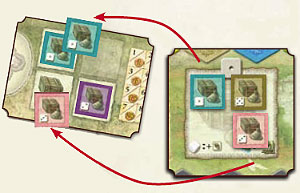
Example: Carla has added a ship to her estate and subsequently takes goods tiles from the goods space shown: the turquoise one (which she adds to her other turquoise good) as well as another one (pink or brown) which she will add to her still-empty goods storage space
2. The player moves his playing piece on the turn order track one space to the right. Should this space be occupied, then he places his piece on top of the other pieces. Should this result in him being start player for the next round then he also receives the white die.
Animal (= a region of connected light green spaces): Whenever a player adds an animal tile to his estate (which can occur up to 6 times), then he immediately receives victory points (and moves his playing piece on the victory point track forward). Each tile has between 2 and 4 animals on it and the player receives the corresponding number of victory points for them.
Should the player already have animals of the same type in the pasture (= a region of connected light green spaces) that the new tile is being added to, then he scores all tiles with the same animal type again in addition to the newlyplaced tile.
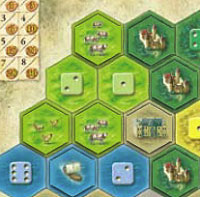
Important: The animal tiles must be part of the same pasture but do not need to be immediately adjacent to the newly-placed animal tile. Tiles with the same animal on them on other pastures are not scored.
Example: Benno adds the topmost 4-cow tile to his estate. He receives 4 + 3 = 7 victory points for it. Should he add another 4-cow tile to this pasture later on, then he would receive 4 + 4 + 3 = 11 victory points for it.

Castle (dark green): Whenever a player adds a castle tile to his estate (which can occur up to 3 times), then he immediately carries out an additional action of his choice as if he had an extra die with any result he wishes at his disposal. He could, for example, immediately add another six-sided tile to his estate, or ...

Mine (grey): These tiles are (with the exception of a few of the yellow tiles) the only ones without an immediate effect when they are placed (which can occur up to 3 times).
Instead, at the end of each phase, the player receives 1 Silverling from the supply for each mine in his estate.
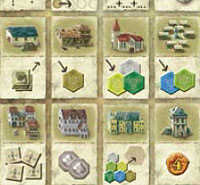
Building (beige): Whenever a player adds a building tile to his estate (which can occur up to 12 times), then he immediately gets to make a single use of that building's advantage.
Important: Each of the 8 building types may only occur once per city (= a region of connected beige spaces). Depending on the estate, there may be between 2 and 6 cities of different sizes (1 to 8 spaces). Estate No. 1, for example, has 4 cities: one 1-size, one 5-size and two 3-size.
Each building provides an advantage immediately after having been built. These are also shown symbolically at left on the player boards.
The buildings

Warehouse
When a player adds a warehouse to his estate, he may immediately (without having to use a die!) sell one goods type of his choice out of his goods storage, exactly as if he had chosen the Sell goods action.

Carpenter's Workshop
When a player adds a carpenter's workshop to his estate, he may immediately take one beige-coloured building tile of his choice from any numbered depot (not from the black depot) and place it onto an empty storage space in the bottom left-hand corner of his board.

Church
When a player adds a church to his estate, he may immediately take one mine (grey), knowledge (yellow) or castle (dark green) tile of his choice from any numbered depot (not from the black depot!) and place it onto an empty storage space in the bottom left-hand corner of his board.

Market
When a player adds a market to his estate, he may immediately take one ship (blue) or animal (light green) tile of his choice from any numbered depot (not from the black depot!) and place it onto an empty storage space in the bottom left-hand corner of his board.

Boarding House
When a player adds a boarding house to his estate, he immediately takes 4 worker tiles from the general supply and adds them to his own.

Bank
When a player adds a bank to his estate, he immediately takes 2 Silverlings from the general supply and adds them to his own.

City Hall
When a player adds a city hall to his estate, he may immediately add a second six-sided tile of his choice to his estate from one of his three storage spaces, regardless of colour (and including all of its effects).

Watchtower
When a player adds a watchtower to his estate, he immediately moves his playing piece on the victory point track forward by 4 spaces.
Fundamentally, when placing all buildings:
Their additional advantages are activated' via their placement, a die result (= action) is not required.
Should a player not be able to make use of a building's advantage (because, for example, there aren't any more blue or light green tiles left in the numbered depots after having placed a market), then the building may still be added (although the advantage is lost in this case).
The supply of worker tiles and Silverlings is not intended to be limited. In the rare case that the supply is exhausted, please substitute other materials.
Additional rules for placing six-sided tiles:
Whenever a player takes a six-sided tile from the game board, he must always first place it onto a storage space in the lower left-hand corner of his board. This is still the case even if he uses his second action to immediately add it to his estate.
Six-sided tiles, once added to an estate, may never be moved or removed.
As soon as a coloured region - regardless of its size - is completely covered with tiles, then this region is considered to be complete and scores victory points in two different ways:
Depending on its size (1 to 8 spaces), the completed region scores between 1 and 36 victory points which are immediately scored on the victory point track.
Additionally, the region - depending on the phase - scores between 10 and 2 victory points: The empty phase space (A-E, in the upper right of the game board) for the current phase indicates how many additional victory points each completed region (regardless of its size!) is worth: between 10 in the first phase
Aand 2 in the last phaseE.

The first player who manages to cover all spaces of one colour in his entire estate with tiles (by placing his third mine, for example, or his sixth animal tile) immediately takes the corresponding large bonus tile from the game board. He immediately scores victory points depending on the number of players (5 victory points with 2 players, 6 victory points with 3 players or 7 victory points with 4 players).

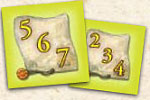
The second player to finish covering up this same colour takes the small bonus tile and the corresponding 2 to 4 victory points. Third and fourth place receive nothing.
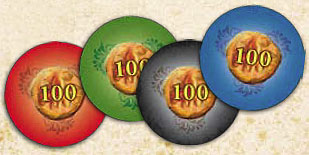
Note: As soon as a player reaches or exceeds 100 victory points on the victory point track, then he places his victory point tile onto his board with the 100 side up.
The tile should be placed in the upper right hand corner, next to the used die storage. When a player reaches 200 victory points, then he flips his tile over.
Action Sell goods

A player may choose to sell all goods of one type from his goods storage.
The die chosen to carry out this action indicates which goods type (= colour) may be sold. All corresponding goods tiles in the player's goods storage are piled, face-down, onto the goods storage space on the player's board intended for this purpose. For doing this, the player receives:
exactly one Silverling from the supply, regardless of how many tiles he just sold (= turned face-down), as well as
2, 3 or 4 victory points per tile (depending on the number of players).
Note: A player must always sell all tiles of a type when choosing the Sell Goods action, even if he would like to keep some in reserve.
Action Take worker tiles

Finally, a player may choose to use any die result to take 2 worker tiles from the general supply. In this case, the die result itself is meaningless.
The central black depot

In addition to his two dice actions, each player may, once per turn, choose to buy one of the six-sided tiles from the central black depot. He may do this at any point during his turn: before, between or after the dice actions.
To accomplish this, the player must return 2 Silverlings to the general supply and subsequently place the newly-purchased six-sided tile, as with any tile from the game board, onto an empty storage space in the lower left-hand corner of his board.
End of a phase
A phase ends after five rounds. Players with mines now receive the corresponding number of Silverlings. Some of the yellow knowledge tiles may also have an effect. The next phase then begins.
End of the game

The game ends after the fifth phase has been played through to completion. Final scoring follows, during which players receive victory points for the following:
- each unsold goods tile: 1 victory point
- each remaining Silverling: 1 victory point
- every two worker tiles: 1 victory point
- each VP-bearing yellow tile.
(Note: Six-sided tiles remaining on the storage spaces of a player's board are not scored).
The player who is the farthest along on the victory point track is the winner. In the case of a tie, the winning player is the tied player with the fewest empty estate spaces. Should there still be a tie, then the winning player is the tied player who went later in turn order.
Continue Reading
